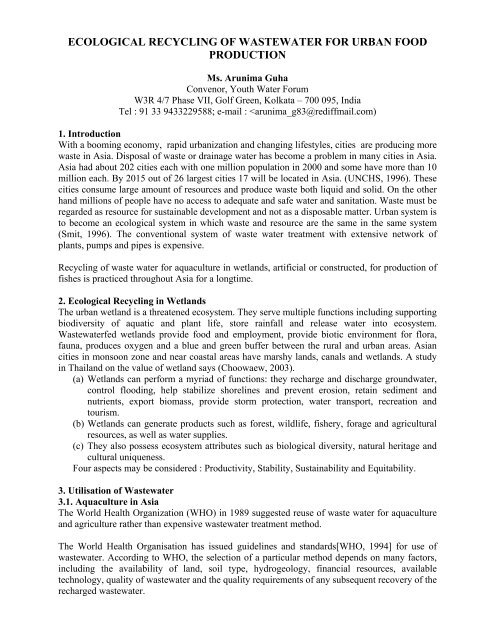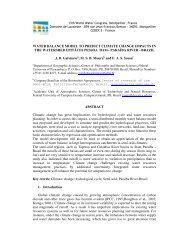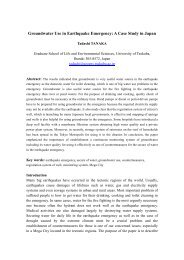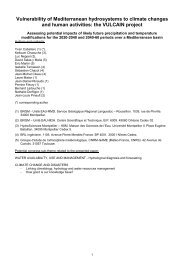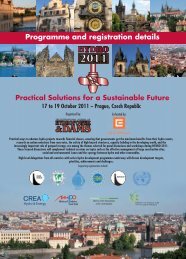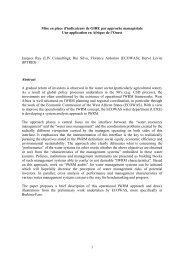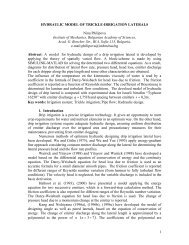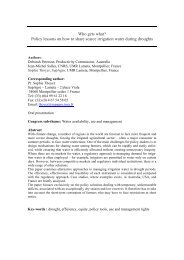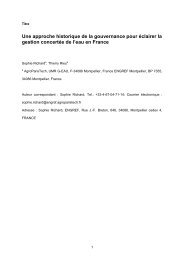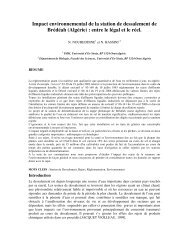ecological recycling of wastewater for urban food production - IWRA
ecological recycling of wastewater for urban food production - IWRA
ecological recycling of wastewater for urban food production - IWRA
Create successful ePaper yourself
Turn your PDF publications into a flip-book with our unique Google optimized e-Paper software.
ECOLOGICAL RECYCLING OF WASTEWATER FOR URBAN FOOD<br />
PRODUCTION<br />
Ms. Arunima Guha<br />
Convenor, Youth Water Forum<br />
W3R 4/7 Phase VII, Golf Green, Kolkata – 700 095, India<br />
Tel : 91 33 9433229588; e-mail :
- The recovery is part <strong>of</strong> a comprehensive <strong>urban</strong> ecosystem strategy. It can be used <strong>for</strong><br />
irrigation <strong>of</strong> roadside plantings, greenery, toilet flushing, industrial reuse including cooling,<br />
agriculture development, fishery etc.<br />
Takashi Asano mentions about three main objectives in waste water treatment (a) a watersupply<br />
to displace the need <strong>for</strong> other sources <strong>of</strong> water (b) a cost effective means <strong>for</strong> the environmentally<br />
sound treatment and disposal <strong>of</strong> <strong>urban</strong> waste water, and (c) an incidental secondary benefit from<br />
the disposal <strong>of</strong> <strong>wastewater</strong> <strong>for</strong> crop <strong>production</strong> by irrigation.[Asano, 2000]<br />
Prism in Bangladesh, a nongovernment organisation in Dhaka has developed a highly successful<br />
duckweed (Sp. Lemnaceae) cropping system <strong>for</strong> both domestic waste water treatment and the<br />
<strong>production</strong> <strong>of</strong> fish protein. Duckweed absorbs almost all chemical substances in the <strong>wastewater</strong><br />
and treated <strong>wastewater</strong> is directed into fish <strong>production</strong> ponds [Ikramullah, 1998].<br />
Haroonabad in Pakistan is using waste water <strong>for</strong> irrigation <strong>for</strong> a longtime. The effluent is mainly<br />
used to irrigate an area <strong>of</strong> 120 ha at the main site and an area <strong>of</strong> 20 ha at two smaller sites despite<br />
possible health and environmental risks. The farmers rely on waste water rather than on water<br />
from poorly managed canal system. The farmers grow high value short duration crop.[Hassan,<br />
2002].<br />
In 1985 China produced 30,000 tons <strong>of</strong> fish from sewage waste waterfed fisheries and it is<br />
reported that most municipal <strong>wastewater</strong> in Chinese cities is drained into various water bodies<br />
that are used as fish ponds[Zhang, 1990]. Current data is not, however, available.<br />
In Hanoi, Vietnam, the most untreated domestic waste water including sewage effluent (70%)<br />
and industrial waste water (30%) is discharged directly into a common sewage and drainage<br />
system <strong>of</strong> 125 km <strong>of</strong> sewers, 15 lakes, 25 canals and 4 main drainage rivers. Waste water flows<br />
in Hanoi by gravity from the city through Thanh Tri district where it has become a valuable<br />
resource. The waste water is being used <strong>for</strong> fish farming, irrigation <strong>of</strong> vegetables and paddy<br />
fields. It produces 3000 tons <strong>of</strong> fish and 20,000 tons <strong>of</strong> vegetable each year.[Thang, 1995] There<br />
are similar examples from India, Thailand, Cambodia, Indonesia, etc. Patankar <strong>of</strong> Indian Water<br />
Works Association has given some estimates <strong>of</strong> quantity <strong>of</strong> waste water supplied to sewage<br />
farms in India (mld) and land <strong>for</strong> farming (ha) in Indian cities such as in Bhopal (16.60 mld and<br />
40.50 ha.). Hyderabad (48.0 mld and 10.85 ha) Varanasi : (82.00 mld and 1020 ha) etc.[Patankar,<br />
2001]. But Kolkata, India has the largest <strong>recycling</strong> district.<br />
3.2. Kolkata case study<br />
Kolkata (Calcutta) has combined system <strong>of</strong> sewerage and drainage, besides the liquid waste,<br />
there is storm water with heavy rainfall 1200 mm <strong>of</strong> which 80% occurs within three months with<br />
highly irregular distribution. In 1966 the World Health Organisation prepared the Master Plan <strong>for</strong><br />
watersupply, sewerage and drainage, later Kolkata Metropolitan Development Authority took up<br />
some civil works channels. The plan divided metroplitan area into several drainage basins.<br />
[Dasgupta, 1991]<br />
Kolkata has the largest <strong>recycling</strong> <strong>of</strong> <strong>wastewater</strong> in the wetland on the eastern fringe <strong>of</strong><br />
metropolitan area. In 1956-60 the total area <strong>of</strong> <strong>recycling</strong>/wetland area was 10,000 ha but due to<br />
large scale conversion into paddy cultivation, vegetable fields and <strong>urban</strong> development total area<br />
is now about 2500 ha which is being reduced by encroachment and development. The annual<br />
yield <strong>of</strong> fish product has fallen from 30000 to 15000 tons. The fish ponds known as ‘bherry’ are<br />
now only about 150 in numbers.
The underground trunk sewer lines <strong>of</strong> Kolkata city are linked with 17 pumping stations, all<br />
located on the eastern fringes. The trunk drain was designed to take the discharge towards a tidal<br />
river on the east.<br />
Utilization <strong>of</strong> resources<br />
Solid & liquid waste<br />
Resources – Water, raw<br />
materials, etc.<br />
Treatment <strong>of</strong> waste<br />
Figure : I Basic principle <strong>of</strong> <strong>wastewater</strong> utilisation<br />
The Kolkata municipal system generates about 750 million litres <strong>of</strong> water daily and 2500 mt <strong>of</strong><br />
solid waste is disposed on east Kolkata near the wetland. After separating the paper, plastics and<br />
metals, the waste is naturally composted. The natural compost is used in the <strong>production</strong> <strong>of</strong> good<br />
quality vegetables (150 mt/day) without adding any fertiliser but sometimes the nutrient rich<br />
sewage fed waste water or sludge is used. The local fishermen were practicing the sewage fed<br />
fisheries on wetland <strong>for</strong> many years. Fish and vegetables meet about 25% <strong>of</strong> the need <strong>of</strong> the city.<br />
The pond unit each <strong>of</strong> lagoon type (between 7 ha – 10 ha in size) is to facilitiate natural aeration<br />
through wind action <strong>of</strong> shallow depth about 1.5 metre to allow sufficient sunlight to reach upto<br />
its bottom to promote growth <strong>of</strong> algae and photosynthetic oxygen is fitted usually with two sluice<br />
boxes as inlet and outlet points, <strong>for</strong> periodical sewage feed exchange from the city’s nearest<br />
drainage outflow channels and canals. Using aquatic plant like water hyacinth (Eichhornia<br />
erassipes) and duckweed (Lamnaceae) water is purified and it is also purified by exposure to<br />
sunlight and aeration (oxygenation) enhanced by sun and wind. Oceasional use <strong>of</strong> lime achieves<br />
coagulation and floculation. The State Government declared a Recycling Zone <strong>of</strong> 12000 ha on<br />
the eastern side but this is being threatened by allowing various developments nearby.<br />
In sothewest Kolkata a fishermen’s cooperative at Mudialy has taken lease <strong>of</strong> 15 ponds, 50 ha in<br />
area from the Kolkata Port Trust and 23 million litres <strong>of</strong> waste-sewage water is treated. The area
has been declared as nature park with micro-flora, birds and deers. The <strong>recycling</strong> <strong>of</strong> <strong>urban</strong><br />
drainage process has become an educational centre <strong>for</strong> children.<br />
The process is advocated in other <strong>wastewater</strong> discharge areas. It was found that there were<br />
hundreds <strong>of</strong> outfall in the river hooghly (a tributory <strong>of</strong> the Ganges) in Kolkata and it was found<br />
that to reduce pollution under the Ganga (the Ganges) action plan <strong>of</strong> the Govt. <strong>of</strong> India it would<br />
be very expensive to adopt alternative disposal or treatment. Wetlands, ponds and marshy lands<br />
have been brought under the fisheries and the State Government’s Fisheries Dept is very active.<br />
Three projects in rural fringe <strong>of</strong> metropolitan area have been taken up with the participation <strong>of</strong><br />
local people, fishermen and the village council. Community Based Wetland Ecosystem (CBWE)<br />
has been first introduced in 1995 in Titagarh, a northern industrial town in metropolitan area.<br />
Drainage<br />
pumping<br />
station<br />
Waste water ponds<br />
<strong>for</strong> growing finger<br />
linses and <strong>for</strong> Solidwaste<br />
Agriculture<br />
First user<br />
Waste<br />
water<br />
Fish ponds<br />
Waste<br />
water fish<br />
Second user<br />
Third user Region<br />
Paddy fields<br />
Effluent<br />
Figure II: Successive Utilisation <strong>of</strong> Wastewater in Kolkata Wetlands (Source : USAID, 1995)
There are paddy fields in the fringe area <strong>of</strong> the metropolis and in lower Gangetic area.<br />
Traditionally paddy fields require much water and certain species <strong>of</strong> fish are cultivated but use <strong>of</strong><br />
chemical fertiliser and pesticides have destroyed the species. Experiments are being carried out<br />
to produce fishes in paddy field again with natural process by using <strong>wastewater</strong> to get multiple<br />
benefits.<br />
Figure III : Aquatic Weed to clean water<br />
Figure IV : Fish <strong>production</strong><br />
Waste water treatment is the primary objective, but broader aspects <strong>of</strong> aquaculture, horticulture,<br />
livestock and poultry development, agr<strong>of</strong>orestry etc. are required as buffer between the <strong>urban</strong><br />
and rural areas to prevent sprawl. Industrial employment has declined in many cities and growth<br />
<strong>of</strong> in<strong>for</strong>mal sector employment in aquaculture and agriculture in the wetlands in and around<br />
cities is to be encouraged.<br />
The high productivity <strong>of</strong> these fish ponds is mainly due to rich nutrient element in waste water<br />
like nitrogen, phosphorous, potash, calcium etc and the high alkanity stimulates <strong>production</strong> in the<br />
fish <strong>food</strong> chain. There are several parameters. It generates abundant quantity <strong>of</strong> algael<br />
photosynthetic oxygen at the assured rate <strong>of</strong> 1 gm algae synthesized to produce about 1.25 gm <strong>of</strong><br />
oxygen and thus dissolved oxygen is found to be 0 mg/l at the inlet point to 16.20 mg/l at the<br />
outlet zone. The biochemical oxygen demand (BOD), a critical parameter <strong>of</strong> waste water quality<br />
is 150-180 mg/l at the inlet to about 15-32 mg/l at the outlet. Chatterjee calculates that wetlands<br />
in east Kolkata releases 226.75 kg oxygen/day/ha.[Chatterjee, 1999] Health and hygiene aspects<br />
<strong>of</strong> fish and segetables have been found satisfactory.<br />
A basic manual prepared by USAID advocates integrated wetland system. The wetlands or<br />
natural depressions act as waterbodies to receive city’s <strong>wastewater</strong> can be utilised like these in<br />
Kolkata through sustainable technology <strong>for</strong> <strong>wastewater</strong> treatment and resource recovery and<br />
advantages are : [USAID, 1995].<br />
(a) Reduced consumption <strong>of</strong> conventional energy<br />
(b) A flexible system<br />
(c) More efficient removal <strong>of</strong> coli<strong>for</strong>ms<br />
(d) Encouraging <strong>food</strong> scarcity<br />
(e) Contributes to rural development<br />
(f) Institutionalizes participation <strong>of</strong> the stakeholders<br />
(g) Longer life span <strong>of</strong> the treatment facility<br />
(h) Minimum construction
The <strong>recycling</strong> <strong>of</strong> <strong>urban</strong> drainage system <strong>for</strong> productive reuse is yet to be integrated in the landuse<br />
plan <strong>for</strong> the cities. There are also health aspects with monitoring and control. Further research is<br />
required <strong>for</strong> institutional aspects. Education, training and public awareness are also essential.<br />
There are several lesions learnt from Kolkata examples<br />
(a) Wastewater can be a part <strong>of</strong> overall water resource plan especially in cities. It has many<br />
benefits, one <strong>of</strong> them is to replace fresh water supply <strong>for</strong> irrigation, aquaculture, industrial<br />
water use, landscape gardening, horticulture etc.<br />
(b) Instead <strong>of</strong> expensive <strong>wastewater</strong> treatment measures, indigenous technology can purify<br />
the waste water, with exposure to sunlight and use <strong>of</strong> aquatic plants.<br />
(c) Sewagefed <strong>wastewater</strong> can be utilized by recycle <strong>for</strong> <strong>production</strong> <strong>of</strong> fish and such water<br />
can be used with sludge and natural compost <strong>for</strong> <strong>production</strong> <strong>of</strong> vegetables. Increasingly<br />
such practice is being used in many countries in Asia, Africa and Latin America.<br />
(d) It provides employment and poor farmers and fishermen can organize themselves into<br />
cooperative society and it can be a best practice with multiple stakeholders.<br />
(e) It improves environment with more oxygen and controls pollution.<br />
(f) It is cost effective process. It eliminates transport, marketing and other costs.<br />
(g) It can be a tool <strong>of</strong> good land management, creates a buffer zone <strong>of</strong> green and blue<br />
between <strong>urban</strong> and rural areas and leads to sustainable development.<br />
(h) Health and hygiene aspects will be a lesson after necessary regulation, control and<br />
standards.<br />
4. Wetlands Livelihood Options<br />
The wetlands with productive ecosystem can provide <strong>food</strong> mostly in developing countries. More<br />
and more cities in India, China, Vietnam, Bangladesh and other countries are practicing<br />
aquaculture <strong>for</strong> <strong>production</strong> <strong>of</strong> fishes and edible aquatic plants and using wetland water and<br />
sludge <strong>for</strong> vegetable <strong>production</strong> in nearby or surrounding areas. Stephanie Buchler et al<br />
(Buechler, 2002) <strong>of</strong> IWMI advocates developing typologies <strong>of</strong> waste water use <strong>for</strong> the purpose <strong>of</strong><br />
standardizing categories as there are also health related aspects. Wetlands have high potential<br />
<strong>for</strong> <strong>food</strong> <strong>production</strong>.<br />
It is estimated that about 2.4 million people in Bengal (Indian part) are presently dependent on<br />
wetland products <strong>for</strong> their subsistence (Ghosh, Dr. S, 2004). There are more than 380 wetland<br />
plants and more than 44 species are important as <strong>food</strong> and vegetables. Traditional commercial<br />
practices include indigenous building materials, aquatic plant <strong>for</strong> ornamental handicraft, mats,<br />
nuts, water chestnut, lotus, aquarium plant, supplementary vegetables are medicinal herbs.<br />
5. Impact <strong>of</strong> Climate Change<br />
Asia has a large coast line and <strong>urban</strong>isation has taken place on the coastal side in many countries<br />
and such areas are in low land with wetlands, estuaries and marshy areas. Due to unsustainable<br />
pattern <strong>of</strong> development many <strong>of</strong> the wetlands have been filled up or encroached and livelihood <strong>of</strong><br />
poor people depending on such wetlands have suffered. The recent economic boom in Asian<br />
countries are causing <strong>ecological</strong> doom as the wetlands are part <strong>of</strong> ecosystem. There is high risk<br />
<strong>of</strong> climate change in low elevation coastal zones. Large areas are likely to be florded. There will<br />
be salt water intrusion affecting agri-aquaculture. Climatic hazards are evident in flooding and<br />
drought, wetland which have shallow depth are damaged, either because <strong>of</strong> flooding or because<br />
<strong>of</strong> evaporation. The impact <strong>of</strong> climatic change on the ecosystem <strong>of</strong> wetlands is yet to be studied.
6. Conclusion<br />
Wastewater <strong>recycling</strong> should be part <strong>of</strong> integrated water resource management plan “Reduce,<br />
recycle and reuse” is one <strong>of</strong> the environment policies to be adopted and the waste must be<br />
regarded as resource <strong>for</strong> sustainable development. Often indigenous treatment <strong>of</strong> <strong>urban</strong> drainage<br />
is better than chemical mechanical treatment and disposal. The agri-horti-aqua-culture in the<br />
periphery <strong>of</strong> cities has multiple benefits providing employment, nutrition and <strong>food</strong> security,<br />
better environment, land and water management etc, with green and blue landscape creating an<br />
<strong>ecological</strong> balance and a buffer between the <strong>urban</strong> and rural areas. [Ghosh, 2007]<br />
Acknowledgement<br />
The author acknowledges the support and technical input from Pr<strong>of</strong>. Santosh Ghosh, President,<br />
Centre <strong>for</strong> Built Environment, Kolkata, India.<br />
References<br />
Asano, Takashi . Waste water management and reuse in megacities. In Juha Uitto and Asit K<br />
Biswas, (eds) ‘Water <strong>for</strong> Urban areas, challenges and prospective’. United Nations<br />
University Press, Tokyo, 2000.<br />
Buechler, Stephanie et al. ‘Waste watr use in <strong>urban</strong> agriculture’ in Urban Agriculture Megazine,<br />
No. 8 December, 2002.<br />
Chatterjee Sivabrata. Wetland preservation and its importance <strong>for</strong> Calcutta. In Wetland and <strong>urban</strong><br />
Environment Report, Centre <strong>for</strong> Urban Economic Studies, Calcutta University, Calcutta, 1999.<br />
Choowaew, Dr. Sansanee. Sustainable Wetlands Development, Mohidol University, Bangkok,<br />
2003.<br />
Dasgupta, Subir. Drainage <strong>of</strong> the Calcutta Area : An overview in Biplab Dusgupta, et al, eds<br />
‘Calcutta’s ‘Urban Future’ Calcutta, Govt. <strong>of</strong> West Bengal, 1991.<br />
Edwards, Peter. Reuse <strong>of</strong> human waste in Aquaculture. UNDP-the World Bank, Washington DC,<br />
1992.<br />
Ghosh, Santosh. Indigenous Technology in <strong>urban</strong> waste water management and <strong>food</strong> <strong>production</strong>.<br />
Paper at International Congress on Wastewater treatment <strong>for</strong> Small Communities, Sevilla,<br />
Spain, 2007.<br />
Ghosh Dr. S.. Traditional Commercial Practices in Sustainable Development and Conservation<br />
in Wetlands. A paper at 3 rd IUCN World Conservation Congress, Bangkok, November,<br />
2004.<br />
Hassan, Mehmood Ul. Maximizing private and social gains <strong>of</strong> waste water agriculture in<br />
Haroonabed in Urban Agriculture Magagine, no. 7, August, 2002.<br />
Ikramullah, M. Lamnaceae based waste water treatment, Dhaka. Prism, Bangledsh, Dhanmondi,<br />
Dhaka, 1995.
Patankar, Sn. Use <strong>of</strong> treated <strong>wastewater</strong> – a study <strong>of</strong> agriculture, in India, case study, Paper Asian at workshop<br />
on <strong>wastewater</strong> reuse management. ICID Congress, September 2001. Seoul, 2001.<br />
Smit, Jac. et al. Urban Agriculture, Foods, Job and Sustainable Cities, UNDP, New York, 1996.<br />
Thang, Van Quet et al. Some Public Health, Aspects <strong>of</strong> Sewage Utilisation <strong>for</strong> fish farming and<br />
irrigation in Hanoi, Vietnam, IDRC Research project. Paper at International workshop on<br />
<strong>urban</strong> Agriculture, December 1995. Centre <strong>for</strong> Built Environment, Kolkata.<br />
UNCHS, Habitat. An Urbanising World : Global Report on Human settlements. Ox<strong>for</strong>d, Ox<strong>for</strong>d<br />
University Press, Ox<strong>for</strong>d, UK, 1996.<br />
USAID. Integrated wetland system (IWS) <strong>for</strong> Wastewater Treatment and Recycling, <strong>for</strong> the<br />
poorer parts <strong>of</strong> the World with ample sunshine. Basic Manual, USAID, Arlington,<br />
Virginia, USA, 1995.<br />
WHO (World Health Organisation). Guidelines and standards <strong>for</strong> the use <strong>of</strong> <strong>wastewater</strong>. WHO,<br />
Geneva, 1994.<br />
Zhang ZS. Wasterwater fed fish culture in China. In P Edwards and RSV Pullian (eds), Waste<br />
water <strong>for</strong> Aquaculture. Asian Institute <strong>of</strong> Technology, Bangkok, 1990.


